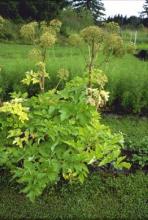
Angelica
Angelica archangelica
This stately and ‘divine’ member of the Parsley family (Apiaceae) is an imposing presence in any garden, with its large globular flowers on a six-foot stalk. It is harvested for the warm, spicy root, usually in the first year before the flower stalk appears. Being a biennial, Angelica dies after flowering, leaving a rotten, empty root behind. It likes moist soil that is fairly rich and deep: its natural environment is beside streams in woodland clearings.
Elemental associations: Fire
Phytochemistry: Essential oils, coumarins, bitter principles, tannin (D. Hoffmann)
Actions: Carminative, diuretic, diaphoretic, relaxant
Specific systems: Digestive, musculature
This is a very special plant. She has one of the more forceful, powerful spirits I have encountered, while at the same time being quite gentle and ‘understanding’. The power of Angelica resides primarily in its warmth and spiciness: it is used to treat a variety of deficient conditions, lacking in Vital Force, where the affected systems are almost empty (the way Angelica stalks are, hollow, as Stephen Buhner once remarked). Its principal use is in digestive deficiency, and it stimulates appetite quite well, strengthening a weak stomach and helping to eliminate gas.
Its relaxing power make it a useful remedy for excessive cramping and muscular inflammation (mostly in ‘cold’ conditions, where there is some type of blockage; not as much for inflammatory conditions such as Multiple Sclerosis).
Indications: Digestive upset, flatulence, incomplete digestion, dismenorrhea, rheumatism
Contraindications: Pregnancy
Preparation/Dosage: A decoction can be made with a TBS of the dry root in a quart of water, simmered for at least 20 minutes. Alternatively, the tincture of the fresh root is excellent and quite tasty as an aperitif, prepared at 50% alcohol, 1:3 to 1:5. Take ½ to 1 tsp. 15 minutes before meals
